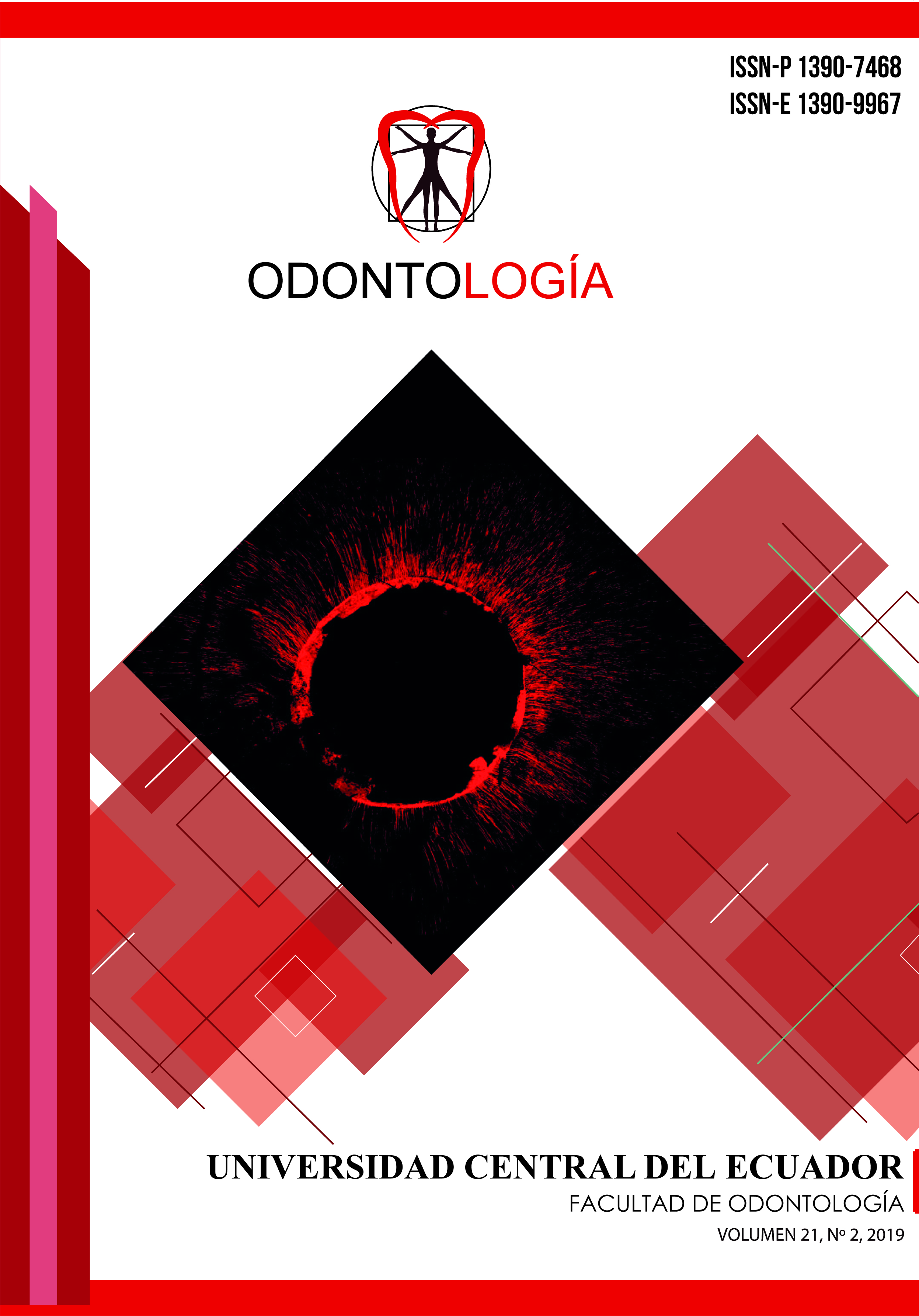Marginal adaptation and tensile strength of interim crowns with two biomaterials
DOI:
https://doi.org/10.29166/odontologia.vol21.n2.2019-19-38Keywords:
Provisional dental restoration, crowns, marginal dental adaptation, tensile strength, dental cements, biocompatible materialsAbstract
Among the requirements that must be carried out by a provisional restoration, the precise marginal adaptation and adequate sealing of the temporary cementing agent stand out. Objective: To compare the marginal adaptation and tensile strength of temporary crowns made of thermo-curing acrylic and resin, cemented with two types of biomaterial. Methodology: In vitro study. 40 upper premolars were carved to receive a complete crown that was made with two types of provisional biomaterial (n = 20): Veracril® thermosetting acrylic and Temp Basic® resin - CAD / CAM. The crowns were cemented with two temporary cementing agents (Dycal® and TempBond NE®), marginal adaptation was observed by means of a stereo microscope; then, they were subjected to thermocycling for 2,500 cycles and then a second observation and measurement was performed, finally tensile tests were performed. Results: Kruskal Wallis found significant differences between the groups in both study times. The groups cemented with Dycal® presented better marginal sealing before and after thermocycling and greater tensile strength than those cemented with TempBond NE® (p = <0.05). In all groups the marginal adaptation was lower after thermocycling (p = <0.05). By means of the Pearson coefficient, a negative correlation (- 0.97) was determined between marginal maladjustment and tensile strength. Conclusions: The marginal microleakage is related to the cement used, the provisional crowns cemented with Dycal® presented statistically lower marginal discrepancy and greater retention forces in relation to TempBond NE. The thermocycling process influenced the increase in marginal maladjustment in all groups. When the maladjustment was higher, the tensile strength decreased.
Downloads
References
Morgano SM, VanBlarcom CW, Ferro KJ, Bartlett DW. The history of The Glossary of Prosthodontic Terms. Journal of Prosthetic Dentistry. 2018;119(3):311-2.
Burns DR, Beck DA, Nelson SK. A review of selected dental literature on contemporary provisional fixed prosthodontic treatment: report of the Committee on Research in Fixed Prosthodontics of the Academy of Fixed Prosthodontics. The Journal of prosthetic dentistry. 2003;90(5):474-97.
Zortuk M, Ozdemir E, Aguloglu S. Evaluating the fracture strength of three different provisional crowns. J Int Dent Med Res. 2010;3(1):25-8.
Patras M, Naka O, Doukoudakis S, Pissiotis A. Management of provisional restorations' deficiencies: a literature review. Journal of esthetic and restorative dentistry. 2012;24(1):26-38.
Montero PC, López MM, Chaves SR. Análisis del nivel de éxito que se logra en el tratamiento del ajuste marginal de coronas temporales con acrílico convencional NEW STETIC® en comparación con el bys-acrílico structur Premium de Voco® en premolares inferiores. 2011.
Dureja I, Yadav B, Malhotra P, Dabas N, Bhargava A, Pahwa R. A comparative evaluation of vertical marginal fit of provisional crowns fabricated by computer-aided design/computer-aided manufacturing technique and direct (intraoral technique) and flexural strength of the materials: An in vitro study. The Journal of Indian Prosthodontic Society. 2018;18(4):314.
Ozcelik TB, Yilmaz B, Seker E, Shah K. Marginal Adaptation of Provisional CAD/CAM Restorations Fabricated Using Various Simulated Digital Cement Space Settings. 2018.
Amin BM, Aras MA, Chitre V. A comparative evaluation of the marginal accuracy of crowns fabricated from four commercially available provisional materials: An in vitro study. Contemporary clinical dentistry. 2015;6(2):161.
Givens Jr EJ, Neiva G, Yaman P, Dennison JB. Marginal adaptation and color stability of four provisional materials. Journal of prosthodontics. 2008;17(2):97-101.
Abdullah AO, Tsitrou EA, Pollington S. Comparative in vitro evaluation of CAD/CAM vs conventional provisional crowns. Journal of Applied Oral Science. 2016;24(3):258-63.
Renne W, Wolf B, Kessler R, McPherson K, Mennito AS. Evaluation of the marginal fit of CAD/CAM crowns fabricated using two different chairside CAD/CAM systems on preparations of varying quality. Journal of Esthetic and Restorative Dentistry. 2015;27(4):194-202.
Mously HA, Finkelman M, Zandparsa R, Hirayama H. Marginal and internal adaptation of ceramic crown restorations fabricated with CAD/CAM technology and the heat-press technique. The Journal of prosthetic dentistry. 2014;112(2):249-56.
Perry RD, Magnuson B. Provisional materials: key components of interim fixed restorations. Compendium of continuing education in dentistry (Jamesburg, NJ: 1995). 2012;33(1):59-60.
Huettig F, Prutscher A, Goldammer C, Kreutzer CA, Weber H. First clinical experiences with CAD/CAM-fabricated PMMA-based fixed dental prostheses as long-term temporaries. Clinical oral investigations. 2016;20(1):161-8.
Ehrenberg D, Weiner GI, Weiner S. Long-term effects of storage and thermal cycling on the marginal adaptation of provisional resin crowns: a pilot study. The Journal of prosthetic dentistry. 2006;95(3):230-6.
Peñate L, Basilio J, Roig M, Mercadé M. Comparative study of interim materials for direct fixed dental prostheses and their fabrication with CAD/CAM technique. The Journal of prosthetic dentistry. 2015;114(2):248-53.
Yao J, Li J, Wang Y, Huang H. Comparison of the flexural strength and marginal accuracy of traditional and CAD/CAM interim materials before and after thermal cycling. The Journal of prosthetic dentistry. 2014;112(3):649-57.
Balkenhol M, Ferger P, Mautner MC, Wöstmann B. Provisional crown and fixed partial denture materials: mechanical properties and degree of conversion. Dental Materials. 2007;23(12):1574-83.
Pegoraro LF, Valle ALd, Araujo CdRPd, Bonfante Gd, Conti PCR, Bonachela V. Prótesis fija. Prótesis fija2001.
Lee W-S, Lee D-H, Lee K-B. Evaluation of internal fit of interim crown fabricated with CAD/CAM milling and 3D printing system. The journal of advanced prosthodontics. 2017;9(4):265-70.
Akashi AE, Francischone CE, Tokutsune E. Effects of different types of temporary cements on the tensile strength and marginal adaptation of crowns on implants. Journal of Adhesive Dentistry. 2002;4(4).
Román-Rodríguez J-L, Millan-Martínez D, Fons-Font A, Agustín-Panadero R, Fernández-Estevan L. Traction test of temporary dental cements. Journal of clinical and experimental dentistry. 2017;9(4):e564.
Fernandes PFS, Vide PAFB, Almeida TC, do Amaral TD, Silva CL, Fernandes JCAS. Retencao de Cimentos Provisorios em Dentes Naturais para Próteses Fixas Unitárias. Revista Portuguesa de Estomatologia, Medicina Dentária e Cirurgia Maxilofacial. 2007;48(4):215-9.
Rego MRdM, Santiago LC. Retention of provisional crowns cemented with eight temporary cements: comparative study. Journal of applied oral science. 2004;12(3):209-12.
Published
How to Cite
Issue
Section
License
Copyright (c) 2020 Paola Elisabeth Casanova Obando, María Fernanda Alarcón Larco

This work is licensed under a Creative Commons Attribution-NonCommercial-NoDerivatives 4.0 International License.


